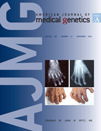Rhombencephalosynapsis is a malformation deserving of further study†
How to Cite this Article: Ramocki M, Scaglia F, Jones J, Clark G. 2011. Rhombencephalosynapsis is a malformation deserving of further study. Am J Med Genet Part A 155: 2902–2902.
To the Editor:
We are appreciative of Dr. Guleria's thoughtful comments on our recent article that reported two half-sisters with holoprosencephaly and partial rhombencephalosynapsis (RES) associated with mutation in the ZIC2 gene. Dr. Guleria's contention that the patients are mislabeled as partial RES due to crowding of the posterior fossa raises a point that is very controversial within the neurology and neuroimaging fields. We reviewed numerous cases where the posterior fossa is crowded (primarily in the setting of a Chiari II malformation) along with normal cerebellum images before we arrived at our conclusion that there is an inappropriate degree of fusion of cerebellar tissue across the midline in these two sisters, which we chose to label as partial RES. We cannot further support this conclusion in the absence of neuropathological examination.
In one large neuropathological case series, the authors analyzed fetal brain tissue obtained subsequent to pregnancy termination and found that of cases with RES, 82% demonstrated complete RES and 18% demonstrated partial RES, thus making a strong argument for the true existence of partial RES [Pasquier et al., 2009]. These authors found that upon neuropathological exam, RES or partial RES was always associated with other brain malformations. We agree that the holoprosencephaly and cerebellar abnormalities observed in our patients are explained together by mutation of ZIC2; this makes sense since ZIC2 has roles in both cerebral and cerebellar development [Nagai et al., 2000; Aruga et al., 2002; Elms et al., 2003]. The open-ended concern that we raise is that while the association of RES with holoprosencephaly is well-documented in the literature, the association remains a rare occurrence suggesting to us that the penetrance and expressivity of RES or partial RES may be strongly influenced by genetic and/or environmental modifiers in some cases.
Dr. Guleria's comments identify a clear need for a more precise classification system for the broad spectrum of cerebellar abnormalities detected on neuroimaging. This discussion is timely given increasing requests for antenatal consultation for the referral indication of cerebellar or posterior fossa abnormality. With future gene mutation discovery efforts and the eventual development of mouse models of RES, we are hopeful that a better understanding of the embryology and developmental insults that lead to the spectrum of brain malformations that include RES will be reached.




